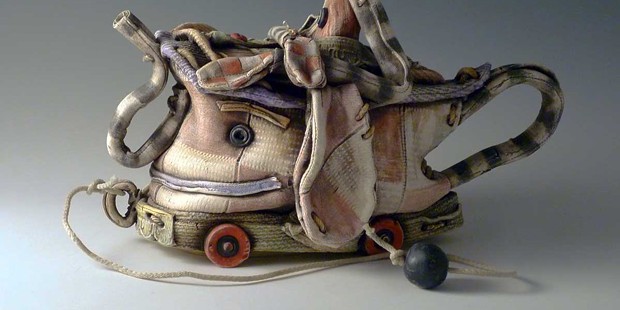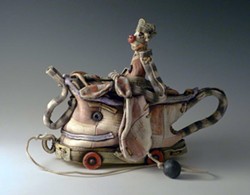Fooling the Eye
Keith Schneider's Selected Works at HSU's Third Street Gallery
By Gabrielle Gopinath[
{
"name": "Top Stories Video Pair",
"insertPoint": "7",
"component": "17087298",
"parentWrapperClass": "fdn-ads-inline-content-block",
"requiredCountToDisplay": "1"
}
]
As director of the ceramics program at Humboldt State University for more than 20 years, Keith Schneider has introduced multiple generations of students to techniques of shaping, throwing and firing clay. Most of his ceramic pieces involve elements that are thrown on a wheel, in addition to pieces that are molded by hand or slab-built. He prides himself on craft.
The artist described the process that results in a finished work like "Pulltoy Teapot no. 1" (2014): "I start on the potter's wheel and make an armature. I make the throwing parts, then the parts that are press-molded or slab-built." The undulating webbing that runs along the surface of many pieces, seemingly holding them together like a package bow, is made from thin clay slabs. "Clay slip is the glue that holds all the different parts together. Once they are put together," Schneider concludes, "I dry them and fire them, and then it's time to put the color on." After painting them with a mixture of liquid clay and color, Schneider typically fires vessels in the kiln four or five times.
The finished works depict whimsical animal characters, resembling crudely handmade toys that pioneer ancestors might have made to amuse their children. These woebegone puppies and bunnies appear as though they've seen better days, thanks to Schneider's meticulous craft. In pieces like "Waldo" and "Al," patches, missing legs, "threadbare" surfaces and button eyes telegraph backstory while soliciting pathos.
These pieces distinguish themselves from most other area potters' wares in two ways. First, unlike most potters' productions they are representational. With no use value, their "wow" effect derives from the fidelity with which they imitate other materials and surfaces. Secondly, Schneider's pieces are kiln-fired using (relatively) low temperatures that hover around 1,900 degrees, which allows them to retain precision-painted detail and a softly tinted terra-cotta appearance.
It's a strange thing to say of a ceramicist but much of Schneider's work brings to mind paintings made by late 19th century American trompe l'oeil specialists John Peto and William Harnett. The French term translates as "fool the eye," and your eyes do get bamboozled when, in viewing one of these pieces, you notice how accurately fired clay has been mimicking other materials. Schneider's pieces imitate flowing fabric, leather and wood, which are in turn are used to simulate details like buttons, wooden wheels and wooden limbs. "The work started selling," he observed, "because people looked at it and said, ''Say, I can't believe that's real.'"
Irreverent humor was part of the vibe of the California Funk art that Schneider cites as an influence, and puns play a structuring role here. Many characters' shapes are based on the forms of thrown ceramic vessels, a word that becomes a hinge on which the artwork's meaning can pivot: vessel-based forms are provided with vessels of their own, such as a boat or wagon (get it?) so on a certain level the whole experience starts to read like a text-driven joke, the way the sneaky trompe l'oeil of post-minimalist Robert Morris's 1962 wall relief "I-Box" does.
Schneider, who professes no love for conceptualism, says he prefers not to theorize about his work. In conversation he cites California potter Robert Arneson, the California Funk artist Roy De Forest and the mid-20th century art brut painter Jean Dubuffet as sources of inspiration, while singling out New York-based sculptor Jeff Koons's assistant-dependent studio practice for disapproval.
He has written that he is interested in objects that "wear" their history or appear to do so. "To me, this implied history sometimes helps to create something for the viewer take away. With clay, I try to create a sense of age comparable to that of actual objects I am attracted to. The life story that each object could tell remains a mystery, but the hint of its past adds another layer of richness."
Schneider remembers the Los Angeles scene of the 1970s and 1980s, where he grew up, as a simpler, sunnier milieu. He was a Southern California native who grew up in Whittier, so local surf/skate culture was a natural source of influence. "I began surfing at 16 and spent lots of time at the beach," the artist recalled in an interview he recently conducted with Third Street Gallery student interns. "I made surfboards in high school and I made lots of drawings and paintings related to surfing, and looked at artists who made surf art. Music and album cover art was very influential as well. In San Diego, I lived at the beach and I became more immersed in the community scene. I met musicians to play with, and was exposed to lots of different art."
He remembers his upbringing as a chill surf idyll largely devoid of angst. The era's seismic social movements registered chiefly as a vague but heady sense that new possibilities were on the horizon: "I wasn't as aware of it at the time, but the late '60s and early '70s were pivotal in shaping the arts as well as the political climate. I do remember going to anti-war protests and there was a sense of revolution in the air. There was ... the sense that we could change things, and we actually did help stop the war," he said.
"I couldn't help but be influenced by what was going on but I think it was more about attitude and the freedom to try new things," Schneider recalled, adding, "there was little pressure from my parents to choose a career, so we had time to explore for ourselves and ask questions about what was most important to us."
This survey exhibition, assembled by Third Street Gallery curator Jack Bentley with characteristic thoughtfulness and care, brings Schneider's ceramics together with mixed-media assemblage pieces and represents a unique opportunity to view these different categories of the artist's practice side by side.
Selected Works: Drawing, Mixed-Media and Ceramics by Keith Schneider runs through May 13 at Humboldt State University's Third Street Gallery (416 Third Street, Eureka).
Gabrielle Gopinath is an art writer, critic and curator based in Arcata.
Speaking of...
-
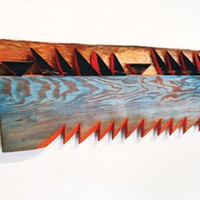
Full Circle Journey
Oct 26, 2023 -
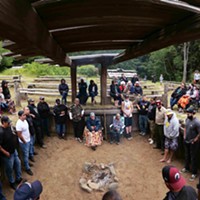
'Given These Songs'
Jun 17, 2021 -
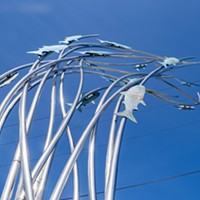
Photos: Flying Fish and a Jolly Giant
May 12, 2021 - More »
more from the author
-
Nancy Tobin's CRy-Baby Installation at CR
- Feb 22, 2024
-
Truth Units
Bachrun LoMele's Burn Pile/The Andromeda Mirage at the Morris Graves
- Sep 7, 2023
-
Ruth Arietta's Illusory Interiors at Morris Graves Museum of Art
- Aug 10, 2023
- More »
